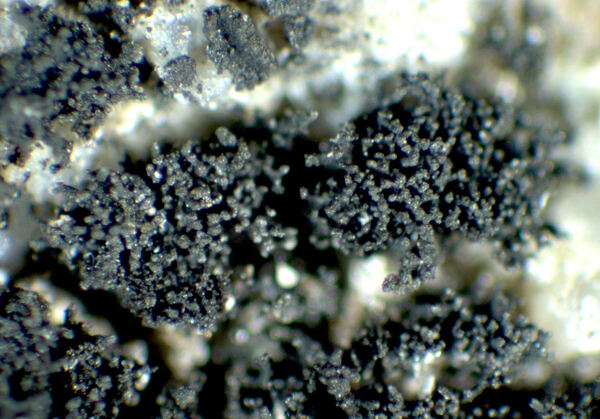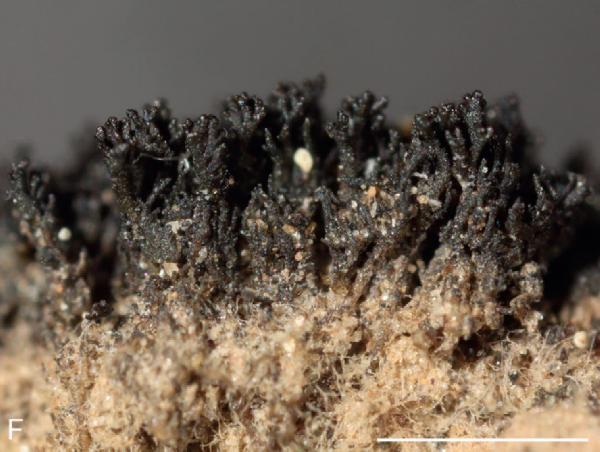Lichinella stipatula Nyl.
Bull. Soc. Linn. Normandie, sér. 2, 6: 301, 1872.
Synonyms: Psorotichia isidiosa Werner?
Distribution: N - TAA, Lomb (De Vita & Valcuvia 2004), Piem (TSB 34176), VA (Matteucci & al. 2013), Emil (Valcuvia & Delucchi 2001, Fariselli & al. 2020), Lig. C - Tosc, Laz, Sar (Monte 1993, Rizzi & al. 2011, Giordani & al. 2013). S - Camp (Nimis & Tretiach 2004, Catalano & al. 2016), Pugl (Nimis & Tretiach 1999), Bas (Bartoli & Puntillo 1998), Cal (Puntillo 1996), Si (Nimis & al. 1996b, Ottonello & al. 2011).
Description: Thallus microfruticose, black, of irregularly cylindrical, irregularly furcate, 0.5-3 mm long, 0.02-0.1 mm thick branches attached by bundles of rhizohyphae, forming regular to mostly irregular, 2-8 mm wide and 2-3 mm tall cushions which are often almost contiguous, giving the impression of a rimose-areolate crust. Central part of branches with a loose, fountain-like hyphal strand consisting of 1-2 rows of 2-3 µm thick hyphae with cylindrical cells, the peripheral parts made up of hyphae with more or less isodiametrical, 2-4 µm wide cells, encircling the photobiont cells. Apothecia thallinocarps, hemiangiocarpous, the ascogonia arising freely beneath the thallus surface, terminal on tips of branches, 0.2-0.3 mm across, with a flat to convex or rarely concave, rough disc, and a thin to thick thalline margin. Thalline exciple up to 50 µm wide; epithecium discontinuous, with scarce clusters of cyanobacterial cells penetrating in a wedge-like form into the hymenium; hymenium colourless, 55-75(-90) µm high, K/I+ blue turning rapidly reddish brown or wine-red, the upper part with groups of photobiont cells intruding between the asci, covered by a more or less continuous layer of sterile thalline tissue; paraphyses 2-3 µm thick, capitate; subhymenium colourless, 20-25 µm thick, K/I+ blue. Asci (16-)24-36(-48)-spored, subcylindrical to obclavate, prototunicate, with a thin, one-layered, non-amyloid wall, an amyloid external apical cap, and passive spore discharge via apical rupturing, Lichina-type. Ascospores 1-celled, hyaline, ellipsoid, (5-)7-9(-10) x 3-4.5 µm. Pycnidia terminal or lateral, globose. Conidia fusiform, c. 3 x 1 µm. Photobiont cyanobacterial, chroococcoid, of a few cells measuring 7-14 x 5-10 µm, penetrated by haustoria and surrounded by a brownish gelatinous sheath. Spot tests: all negative. Chemistry: without lichen substances.
Note: a holarctic lichen found on steeply inclined, sun-exposed seepage tracks of slightly calciferous or basic siliceous rocks, often overgrowing other lichens; rather common in Mediterranean Italy, in the Alps most frequent in dry-warm areas.
Growth form: Fruticose
Substrata: rocks
Photobiont: cyanobacteria, coccaceous (e.g. Gloeocapsa)
Reproductive strategy: mainly sexual
Subcontinental: restricted to areas with a dry-subcontinental climate (e.g. dry Alpine valleys, parts of Mediterranean Italy)
On otherwise dry surfaces with short periods of water seepage after rain
Commonnes-rarity: (info)
Alpine belt: absent
Subalpine belt: absent
Oromediterranean belt: absent
Montane belt: very rare
Submediterranean belt: very rare
Padanian area: extremely rare
Humid submediterranean belt: rather common
Humid mediterranean belt: common
Dry mediterranean belt: rather rare

Predictive model
Herbarium samples
Growth form: Fruticose
Substrata: rocks
Photobiont: cyanobacteria, coccaceous (e.g. Gloeocapsa)
Reproductive strategy: mainly sexual
Subcontinental: restricted to areas with a dry-subcontinental climate (e.g. dry Alpine valleys, parts of Mediterranean Italy)
On otherwise dry surfaces with short periods of water seepage after rain
Commonnes-rarity: (info)
Alpine belt: absent
Subalpine belt: absent
Oromediterranean belt: absent
Montane belt: very rare
Submediterranean belt: very rare
Padanian area: extremely rare
Humid submediterranean belt: rather common
Humid mediterranean belt: common
Dry mediterranean belt: rather rare

Predictive model
| Herbarium samples |
 INDEX FUNGORUM
INDEX FUNGORUM
 GBIF
GBIF
 DOLICHENS
DOLICHENS





